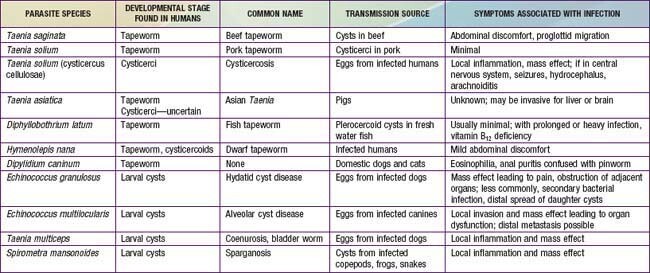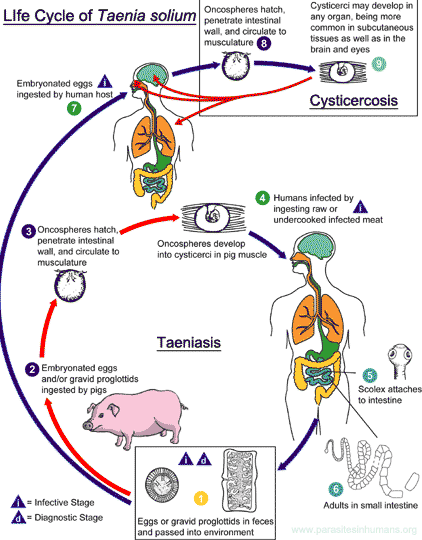Essentials of Diagnosis
- Spheroidal yellow-brown eggs (31-43 um).
- Scolex has hooklets and four suckers.
- Proglottids usually appear as short chains.
- Mature proglottids are square and nonmotile.
- Gravid proglottid has 7-13 lateral branches on each side of uterus.
General Considerations
T solium infection occurs worldwide; endemic areas include Mexico, South and Central America, Africa, Southeast Asia, India, and the Philippines. T solium infection is commonly linked to the ingestion of undercooked pork, although other animals may harbor the larval form of the parasite. Infection may be intestinal, which is typically asymptomatic, or extraintestinal (called cysticercosis, see below), which is caused by larval forms of T solium within the tissues of the human host. Ingestion of encysted T solium larvae is followed by the parasite scolex attaching to the intestinal mucosa, which allows the worm to grow into an adult within 12 weeks. There may be one or more adult worms present for = 25 years, and these may reach lengths of 2 to 7 m. Each worm contains < 1000 proglottids. Identification of species is by the number of lateral branches on the side of the uterus within a gravid uterus.
Taenia solium is more prevalent in regions such as Southeast Asia, Africa, and Latin America, cases have been reported in Australia.
Taenia solium infections are relatively rare in Australia. However, a case report published in the Emerging Infectious Diseases journal documented a 10-year-old child in Timor-Leste, near Australia’s northern border, who was diagnosed with T. solium taeniasis. This highlights the potential for transmission in regions close to Australia.
Clinical Findings
Signs and Symptoms
Infection with the adult worm of T solium is usually asymptomatic, but nonspecific abdominal symptoms including indigestion and nausea may be present.
In Australia, as elsewhere, T. solium infections can present as:
- Taeniasis (often asymptomatic, but may cause nonspecific abdominal symptoms such as indigestion and nausea).
- Cysticercosis (when the larval stage infects tissues, it can lead to neurocysticercosis, presenting with neurological symptoms like seizures and headaches).
Laboratory Findings
Patients with intestinal T solium infection will frequently have abnormal results of stool examinations for ova and parasites and occasionally will have a mild leukocytosis with eosinophilia.
Differential Diagnosis
Since infection with the adult worm of T solium is asymptomatic, the main diagnostic concern in a patient with intestinal T solium is whether the patient has cysticercosis. If the results of evaluation suggest that there is extraintestinal infection, then specific therapy for cysticercosis is required.
Diagnosis typically involves stool examinations for ova and parasites. In Australia, treatment options include:
- Taeniasis – praziquantel or niclosamide are commonly used.
- Cysticercosis – management may require surgical intervention, and for central nervous system involvement, praziquantel or albendazole may be used, with corticosteroids if indicated.
Complications
T solium infection of the intestine is not commonly associated with symptoms; however, in patients with high parasite loads, obstruction may occur.
Treatment
Therapy for T solium infection of the intestine consists of either praziquantel or niclosamide (see Box 2). Follow-up examinations of stool should be performed 1 month after treatment.
Prognosis
The prognosis for patients with intestinal T solium infection is excellent.
Prevention & Control
Prevention from infection with T solium involves adequate cooking of pork and pork products to a > 65 °C core temperature (Box 3). Freezing, pickling, and salting do not prevent infection. Immunization of swine and provision of animal feed that is free of eggs and proglottids are other preventative measures that have been reported to be effective in controlling infection. Since infected humans are capable of transmitting cysticercus to others, enteric precautions should be used, and stool specimens should be handled with attention to decontamination. In addition, adequate facilities for disposal of human sewage should be available.
Preventing T. solium infection in Australia involves ensuring pork is cooked to an internal temperature exceeding 65°C, regular handwashing and proper food handling practices and controlling tapeworm infections in pets through preventive deworming and promptly treating tapeworm infections in pets.
While T. solium infections are uncommon in Australia, awareness and adherence to preventive measures are essential to maintain public health.
Get more information about this infection provided by Health Direct and the World Health Organization.



